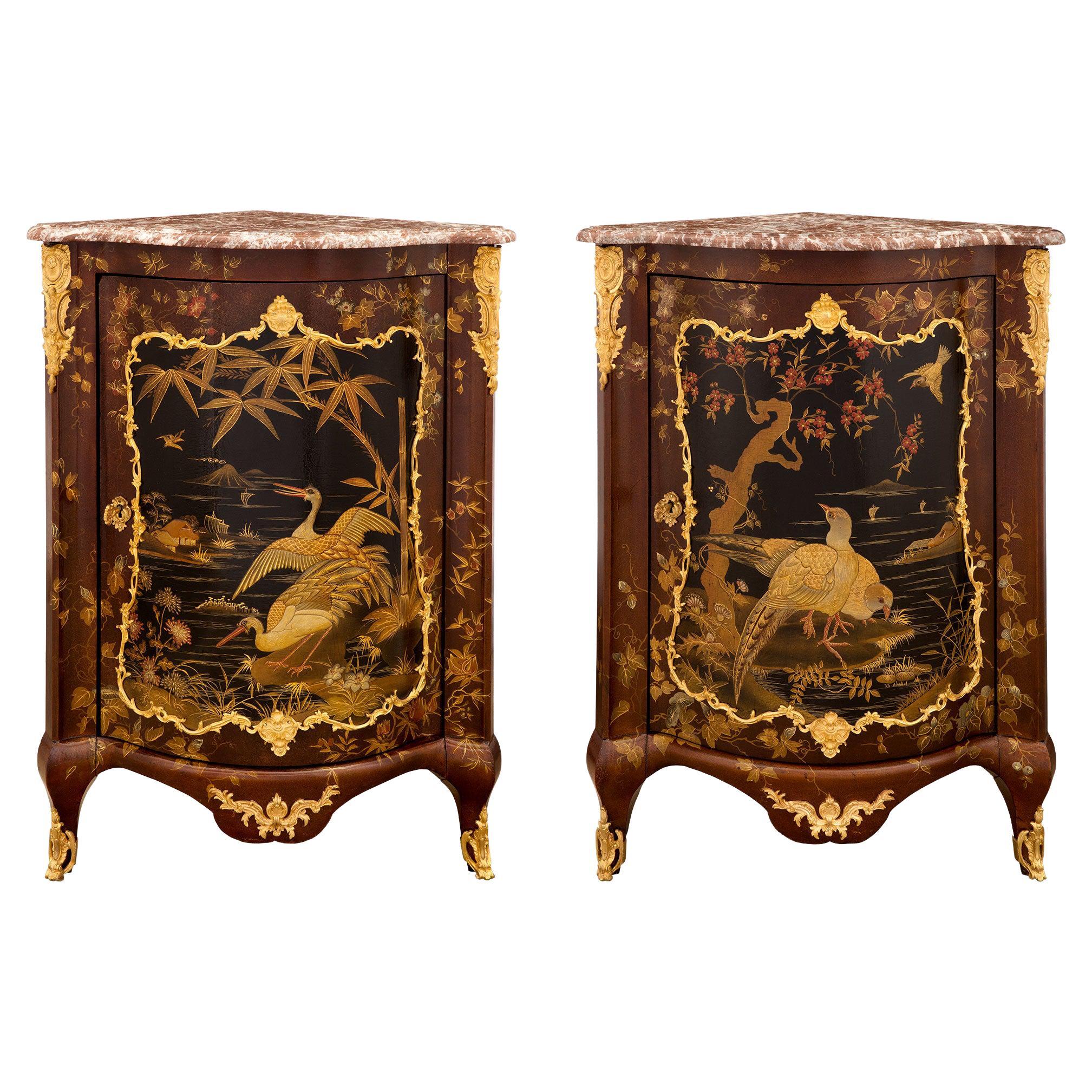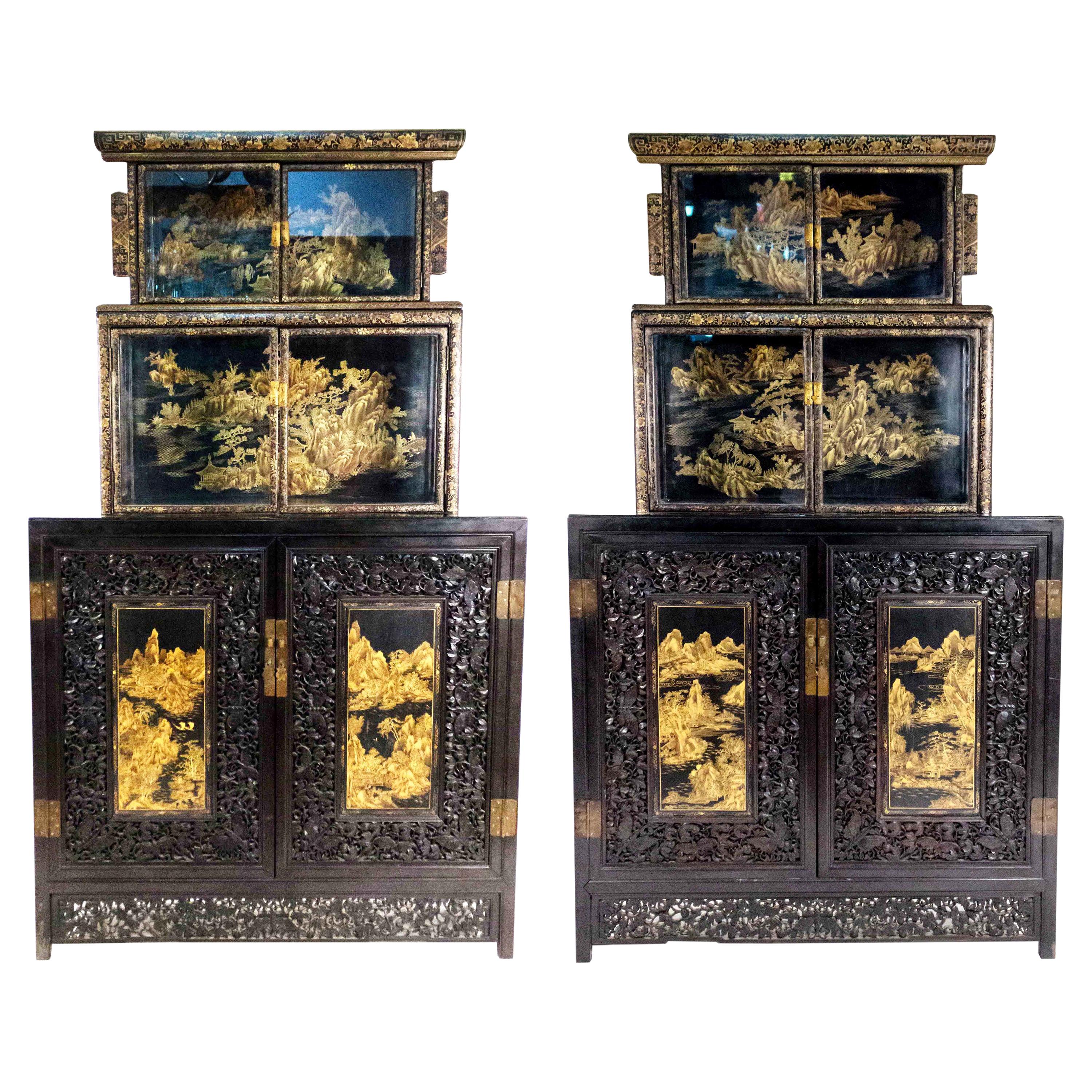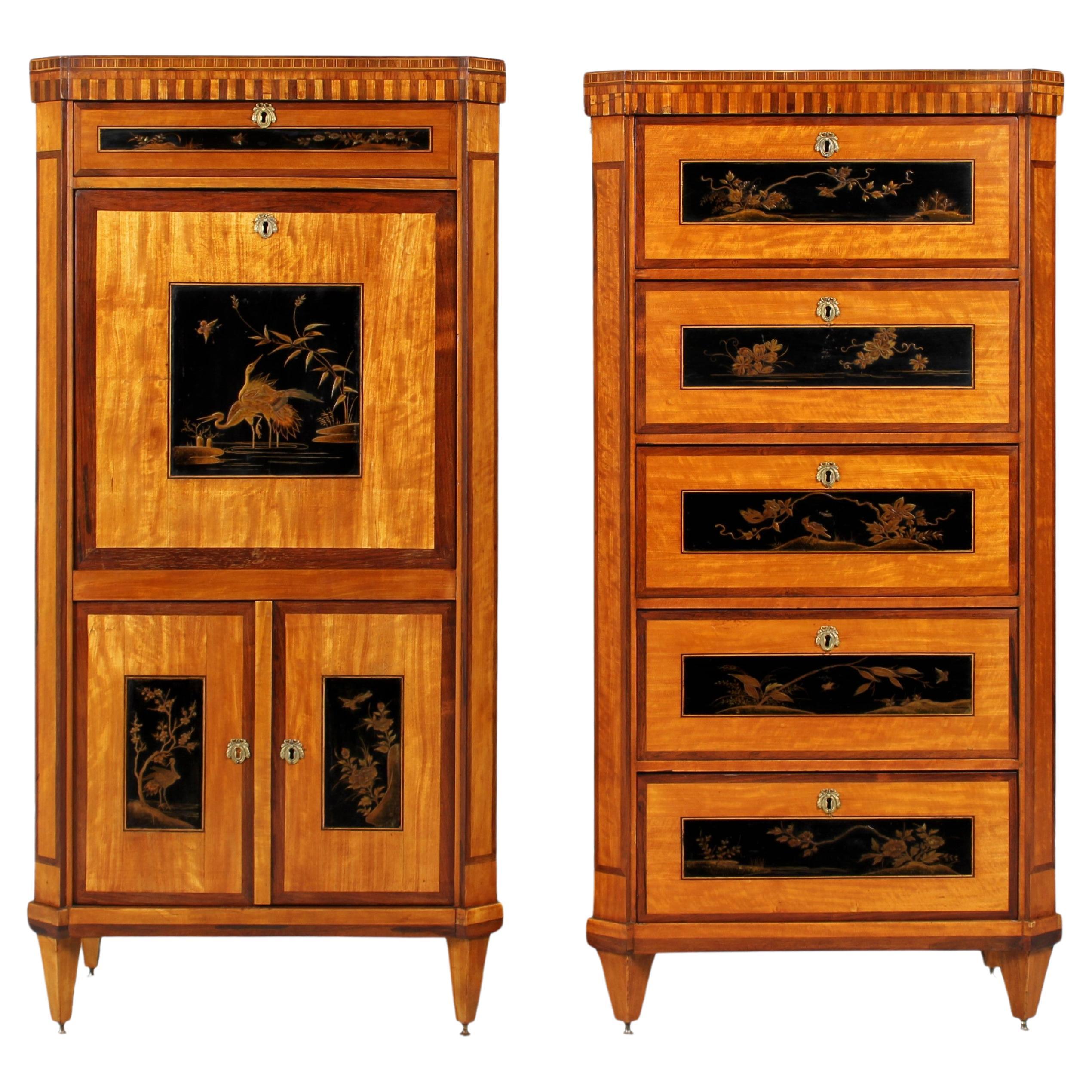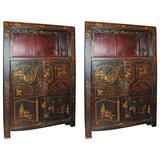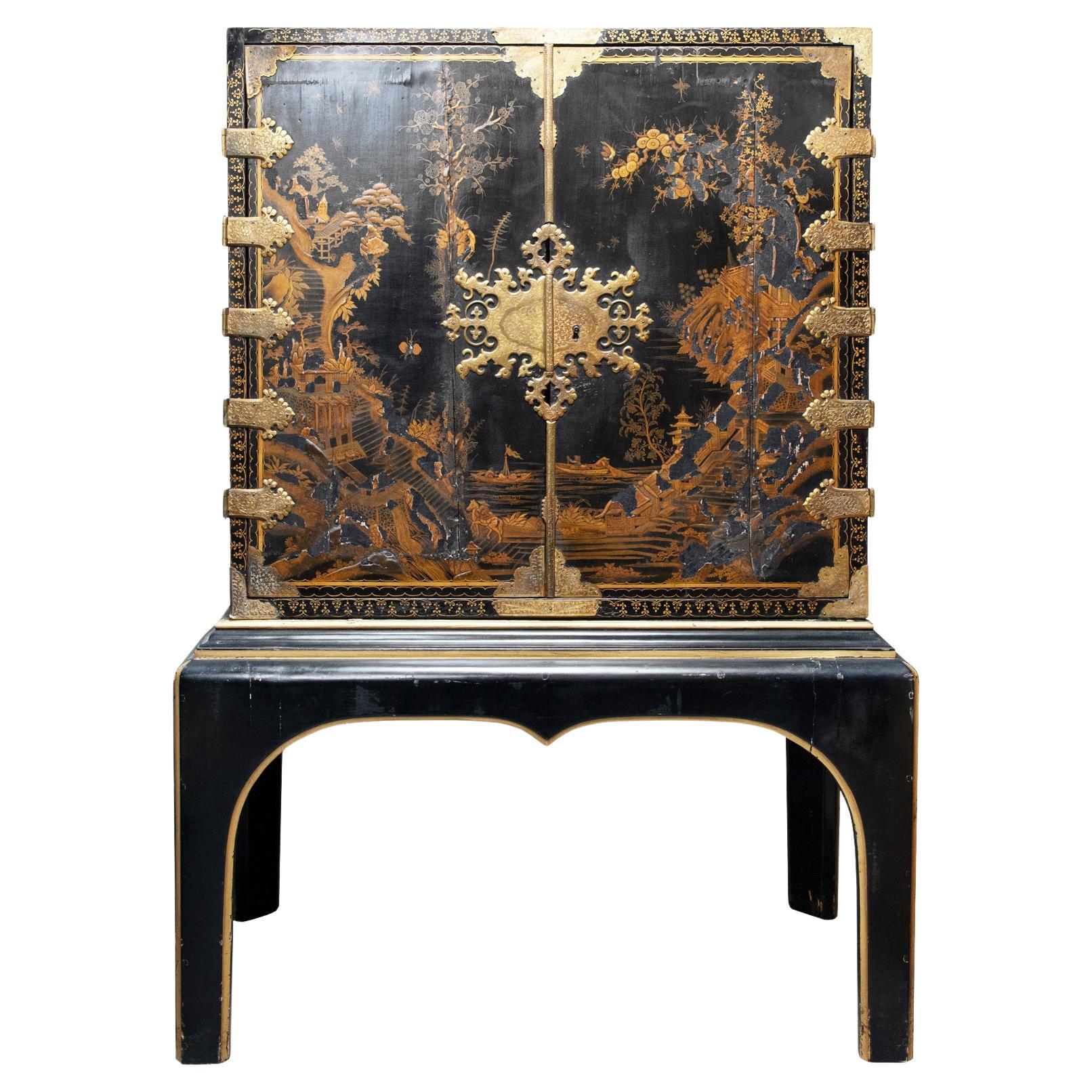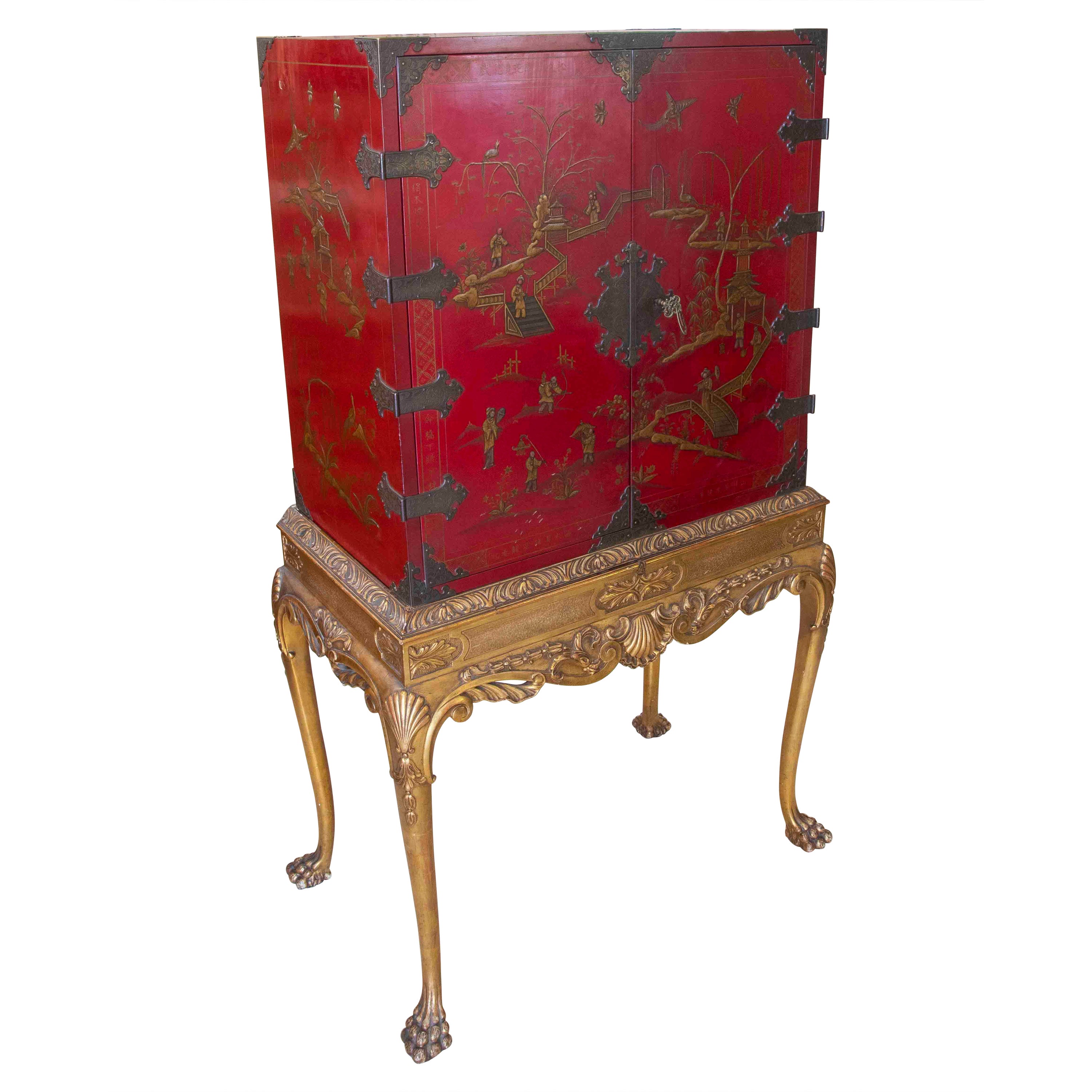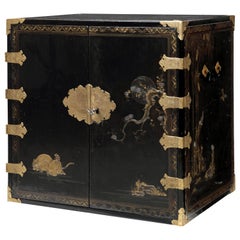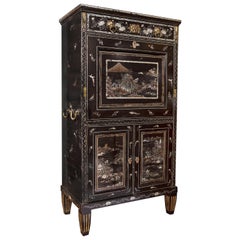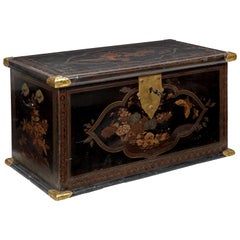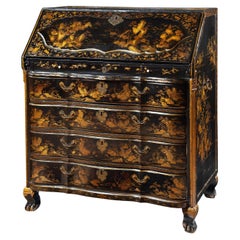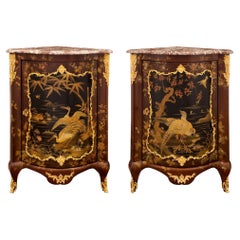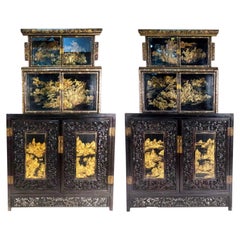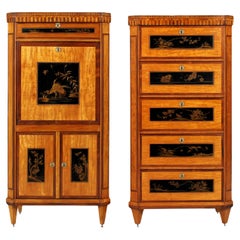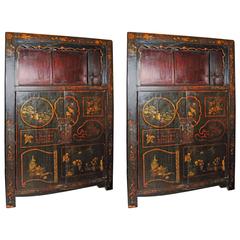Items Similar to A fine pair of Japanese export lacquer secretaires owned by Sir Stamford Raffles
Video Loading
Want more images or videos?
Request additional images or videos from the seller
1 of 11
A fine pair of Japanese export lacquer secretaires owned by Sir Stamford Raffles
$824,031.08per set
£609,345.44per set
€690,000per set
CA$1,131,886.62per set
A$1,258,592.93per set
CHF 658,896.07per set
MX$15,373,947.82per set
NOK 8,279,678.87per set
SEK 7,788,697.26per set
DKK 5,253,818.62per set
About the Item
'The Stamford Raffles Secretaires.'
A pair of Japanese Kyoto-Nagasaki style export lacquer secretaires by ‘Lakwerker Sasaya’ each with the name ‘Olivia’
Kyoto, Edo period, circa 1800-1813
Both secretaires are made according to the French taste of the late 18th/early 19th century. However, they are fully executed in black lacquer over sugi wood (cedar, Cryptomeria japonica), decorated with gold powder, silver powder, mother-of-pearl and gilt metal mounts. They are a superb example of the Kyoto- Nagasaki style of export lacquer, featuring Chinese- inspired landscapes based upon model drawings from the Sasaya Workshop. These drawings can currently be found in the collection of the Rijksmuseum (inv. no. AK-MAK-1734-4).
The upper section of each secretaire has two doors flanked by twisted maki-e decorated columns with gilt metal bases and capitals. The capitals are perfect miniature copies after lifelike examples of the To-Kyou, the upper bracket complex, of columns in traditional earthquake-resistant temple-building, with each tiny element separately stacked. The finely drawn columns are from the early Edo period and have been reused for their fineness. Underneath a retractable board, possibly for candles, a large fall-front writing slope reveals several partitions and drawers decorated with scattered flower sprays. The inside of each fall front boldly displays the signature ‘LAKWERKER SASAYA’, written in gold within an oval border. The lower sections have two large drawers decorated with Chinese-style landscapes within an oval cartouche.
H. 176.5 x W. 101,5 x D. 48 cm (each)
Provenance:
- Probably Sir Thomas Stamford Raffles the founder of Singapore, and Lady Olivia Marianme Stamford Raffles (née Devenish); thence by descent
- Probably Olivia Stamford Raffles Villeneuve, thence by descent to the Hinson Beaver Van der Haas family
Hauteville Antiquaires, Brussels
Private collection, Paris (purchased in the 1980s/early 1990s)
Thence by descent in 2019 and sold at auction in Paris right after
Remarkably, both secretaires, and an included pair of jewellery boxes, bear the name ‘Olivia’, written in elegant hira-maki-e penmanship on the outside, just above the fall front.1 There can’t be any doubt that the present pair of secretaires were presented to Sir Thomas Stamford Raffles, as a gift for his wife Lady Olivia Mariamna Stamford Raffles née Devenish (1771-1814). However, some other options must first be explored to come to a solid provenance. To start, Olivia was a completely unknown name in the Netherlands or the former Dutch East Indies. The first Olivia, or at least the only Olivia from 1750 till 1850, registered in the Dutch East Indies, was the wife of Sir Thomas Stamford Raffles, who was Lieutenant-Governor of Java from 1811 to 1816.
We wrote a complete scientific article about the attribution and provenance. Send us a message to receive it!
- Dimensions:Height: 69.69 in (177 cm)Width: 39.97 in (101.5 cm)Depth: 18.9 in (48 cm)
- Sold As:Set of 2
- Materials and Techniques:
- Place of Origin:
- Period:
- Date of Manufacture:Circa 1800-1813
- Condition:Refinished. Wear consistent with age and use. Restored by Urushi Studio who work with Japanese lacquer-masters: Overall in good condition: European shellac removed; Lacquer re-impregnated; One foot broken and professionally reattached; Minor losses added; Break in panel restored.
- Seller Location:Amsterdam, NL
- Reference Number:1stDibs: LU5458239040902
About the Seller
5.0
Recognized Seller
These prestigious sellers are industry leaders and represent the highest echelon for item quality and design.
Established in 1985
1stDibs seller since 2020
23 sales on 1stDibs
Typical response time: 5 hours
- ShippingRetrieving quote...Shipping from: Amsterdam, Netherlands
- Return Policy
Authenticity Guarantee
In the unlikely event there’s an issue with an item’s authenticity, contact us within 1 year for a full refund. DetailsMoney-Back Guarantee
If your item is not as described, is damaged in transit, or does not arrive, contact us within 7 days for a full refund. Details24-Hour Cancellation
You have a 24-hour grace period in which to reconsider your purchase, with no questions asked.Vetted Professional Sellers
Our world-class sellers must adhere to strict standards for service and quality, maintaining the integrity of our listings.Price-Match Guarantee
If you find that a seller listed the same item for a lower price elsewhere, we’ll match it.Trusted Global Delivery
Our best-in-class carrier network provides specialized shipping options worldwide, including custom delivery.More From This Seller
View AllRare Charming 17th Century Japanese Lacquer Cabinet with Gilt-Bronze Mounts
Located in Amsterdam, NL
A fine Japanese pictoral style lacquer cabinet with gilt-metal mounts
Kyoto, Edo period, 1670-1690
Decorated in Japanese relief lacquer work, black lacquer ground decorated...
Category
Antique Late 17th Century Japanese Furniture
Materials
Bronze
$44,784 Sale Price
25% Off
Free Shipping
Japanese Export Lacquer Mother-of-Pearl Secretaire for the American Market
Located in Amsterdam, NL
A rare Japanese export lacquered secretaire for the American market
Circa 1800-1830, Colonial
Overall densely decorated with flower sprays and landscapes, minutely inlaid with ...
Category
Antique 1810s Japanese Edo Furniture
Materials
Mother-of-Pearl, Wood
Large Royal Early 17th Century Japanese Lacquer Chest with Gilt-Bronze Mounts
Located in Amsterdam, NL
A large Japanese transitional lacquer chest with gilt-metal mounts
Edo period, early 17th century
The rectangular chest with flat hinged lid decorated in gold, silver, and red ...
Category
Antique Early 17th Century Japanese Blanket Chests
Materials
Bronze
18th Century Chinese Export Lacquer Chinoiserie Bureau Desk for the Dutch Market
Located in Amsterdam, NL
An extremely rare, possibly unique, Chinese export lacquer bureau for the Dutch market
Canton, circa 1737
H. 118 x W. 102.5 x D. 63 cm
Provenance:
- Private collection, The Netherlands
- J.K. Driessen Antiques, Arnhem (Art Fair Breda, 1989)
- Noble collection, Belgium
Literature:
- C.J.A. Jörg, ’De handel van de V.O.C. in Oosters lakwerk in de 18de eeuw’ in: Nederlands Kunsthistorisch Jaarboek , Jr. 31 (1980), pp. 355-363 (ill.)
- Annigje Hofstede, Nederlandse meubelen van Barok tot Biedermeier, 1700-1830, Waanders, Zwolle 2004, pp. 35-37 (ill.)
This lacquer bureau is one of the four writing desks purchased in Canton in 1737, and as far as is known, this is the only remaining bureau of its type from the period. As the VOC believed that large pieces of import took up too much valuable space in their trading ships...
Category
Antique Mid-18th Century Chinese Chinese Export Lacquer
Materials
Wood, Cypress, Lacquer
$89,568
Free Shipping
17th Century Japanese Export Lacquer Cabinet with Depiction the Dutch Tradepost
Located in Amsterdam, NL
A highly important Japanese export lacquer cabinet with depiction of the Dutch East India Company tradepost Deshima and the annual Dutch delegation on its way to the Shogun in Edo
Edo period, circa 1660-1680
H. 88 x W. 100.5 x D. 54 cm
This cabinet includes a later European japanned stand, but also a modern powder-coated steel frame.
The latter can be designed and added to your specific needs.
The sides and front of the rectangular two-door cabinet are embellished in gold and silver hiramaki-e and takamaki-e on a black roiro lacquer ground with a continuous design. The two doors depict a long procession of numerous figures travelling on foot and horseback along buildings and a pagoda into a mountainous landscape. This is the annual court journey, Hofreis, of the Dutch from Nagasaki to the Shogun’s court in Edo. Three horseback riders are dressed as Dutch merchants and a fourth figure, probably het Opperhoofd, is seen inside a palanquin, norimon. Just about to cross the bridge, two men are carrying a cabinet like the present one.
Many Japanese figures on either side of the procession are engaged in various activities; some play musical instruments on board of small boats, others are fishing; figures inside buildings are depicted playing go, and farmers are tending to their rice paddocks. The upper part of the right door shows a large mansion, probably the local daimyo’s castle, with men kneeling before a man in the central courtyard.
The court journey fits in with the foreign policy of the shogunate which accorded a role to the VOC alongside China, Korea, and the Ryukyu Islands who also had to pay tribute. However, the VOC employees were traders, having low status in Japan’s social hierarchy, and they were received with less deference than were the state embassies from Korea and the Ryukyu Islands. Nevertheless, the contacts with the Dutch were a welcome source of information to the Shogun about Europe and European science and technology.
The left side of the cabinet depicts, in mirror image, a rare view of the artificial fan-shaped Deshima Island, the trading post for the Dutch in Japan. The island, where the Dutch flag flies, is surrounded by small Japanese boats and an anchored three-masted fluyt (cargo ship), flying Dutch flags, with on the stern the VOC monogram. On the bottom right a busy street of Nagasaki is shown, bordered by shops and leading up to the stone bridge. On the island the trees are beautifully painted, two cows can be seen, and the flagpole, all in very fine detail. Dutchmen and enslaved Malay are visible outside the buildings and two Japanese figures, probably guards, sit in a small hut in the centre.
A maximum of fifteen to twenty Dutchmen lived on the island at any time and soldiers or women were not allowed. Restrictions on Deshima were tight, and the merchants were only allowed to leave the island by special permission. The Opperhoofd had to be replaced every year, and each new Opperhoofd had to make a court journey to pay tribute, present gifts, and to obtain permission to Margaret Barclay eep on trading. In the distance, many birds fly above the hills and a four-story pagoda can be seen. The right side of the cabinet is painted with other horse riders and their retinue journeying through mountains.
The pair of doors to the front open to reveal ten rectangular drawers. The drawers are decorated with scenes of birds in flight and landscapes with trees and plants. The reverse of the left door with two thatched buildings, one with a ladder, underneath a camelia tree with large blooms; the right door with a three-story pagoda nestled among trees and both doors with a flying phoenix, ho-oo bird. The cabinet, with elaborately engraved gilt copper mounts, hinges, lock plates and brass handles, is raised on an 18th-century English japanned wood stand.
A pair of large cabinets...
Category
Antique 17th Century Japanese Edo Lacquer
Materials
Copper, Gold
$1,492,809
Free Shipping
Portuguese-colonial Japanese Namban lacquer Vargueno Cabinet, circa 1600
Located in Amsterdam, NL
A Portuguese-colonial Japanese Namban lacquer vargueno cabinet
Momoyama period, circa 1600
H. 43 x W. 64.5 x D. 36 cm
Wood, black lacquered and deco...
Category
Antique Early 1600s Japanese Antiquities
Materials
Gold, Brass
You May Also Like
Pair of French 19th Century Japanese Lacquer and Marble Encoignure Cabinets
Located in West Palm Beach, FL
A striking and most decorative pair of French 19th century Transitional st. polychrome, Japanese lacquer, ormolu and Sarrancolin marble encoignure cabinets. Each corner cabinet is ra...
Category
Antique 19th Century French Cabinets
Materials
Marble, Ormolu
Pair of 20th Century Chinese Black and Gold Lacquered Three-Tiered Cabinets
Located in Queens, NY
Pair of Chinese black lacquered three-tiered glass and wooden cabinets decorated with landscape scenes and carved borders with brass hardware and detailed interior ( Early 20th Centu...
Category
Early 20th Century Chinese Chinese Export Cabinets
Materials
Glass, Wood
Pair of Louis XVI Style Dutch Chinoiserie Secretary and High Chest
Located in Greven, DE
Pair of chinoiserie furniture - secretary and chiffonier
The Netherlands
Satinwood and others, lacquered panels
around 1890
Dimensions: H x W x D: 130 x 63 x 39 cm
Description:
Ve...
Category
Antique Late 19th Century Dutch Secretaires
Materials
Satinwood
Pair of 19th Century Chinese Scholars Cabinets
Located in New Orleans, LA
Pair of lacquered and decorated Chinese cabinets.
Category
Antique Mid-19th Century French Cupboards
$6,500 / set
Early 18th century Japanese Lacquer Cabinet on Stand
Located in Rīga, LV
Rectangular cabinet has nine drawers inside. Hinges, corner mounts and lock plates in gilt brass. Decorated with river landscapes, insects, birds and animals in pairs. The stand is i...
Category
Antique Early 18th Century English George III Cabinets
Materials
Wood, Lacquer
Chinese Two-Pieces Furniture with Table and Cupboard with Doors and Drawers
Located in Marbella, ES
Chinese Two-Pieces Furniture with Table and Cupboard with Doors and Drawers
Category
Late 20th Century English Chinoiserie Secretaires
Materials
Metal
More Ways To Browse
Antique Cypress
Antique Cypress Furniture
Lacquer Box France
Japanese Metal Box
Japanese Solid Silver
Oval Display Cabinets
Oval Display Case
Display Cabinet Japanese
Used Jewellery Display Cabinets
Japanese Export Silver
Antique Powder Boxes
18th Century Japanned Box
Temple Cabinet
Silver China Cabinet
Antique Dutch Display Cabinet
Black Lacquer Japan Cabinet
Black Lacquer Mother Of Pearl Inlay Furniture
French Jewelry Display Case
